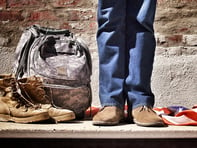Published on
Creating Educational Heliotropism: Adult Learners, America Needs You Back! (Part 2)

Part II: Eliminating the Degree Attainment Barriers: Institutional, Dispositional, and Situational
It’s a funny thing about obstacles: Some of them make you stronger and more determined to push onward to overcome them, but others are simply too substantial to surmount. Still others merely require the appropriate help from our lifelines to guide us through.
Barriers to postsecondary degree attainment are no different. Until institutions understand the lever and the fulcrum, the theory of margin, and the institutional, situational and dispositional barriers that affect access and retention, we will continue to create or perpetuate barriers to degree attainment.
As educators and legislators, we have an enormous responsibility in this honorable mission, but the good news is that we can dismantle the barriers that we contribute to building. Many across the country already are. Simultaneously, by being cognizant of those external situational life obstacles that affect students, we can become those lifelines to mitigate some of their challenges, as well. This is not just wishful thinking. All of this is deeply embedded in select positive psychology, retention research, learning and behavioral theories. Those theories have been swaddled together and translated into practice with positive results. Let’s discover more:
The Power of Margin: The Lever and the Fulcrum
Despite the demographic and delivery modality shifts in higher education, there is not a wealth of applied research focused on what makes underserved learners successful. Throughout the 20th century, educational psychologists emphasized people learn when they are actively and socially engaged in constructing learning by using their prior knowledge to best understand new knowledge they come in contact with. When our team looked to combine behavioral theories with cognitive, social and retention theories, we arrived at the VIP2® and Swaddling Support Services (SSS)® approaches, which are symphonized wrapping (swathing) of purposefully orchestrated support infrastructure for adult success. It’s not rocket science. In fact, it is quite the opposite. The irony within the approach is that it transforms the utterly complex (including decades of theories) into something so lucidly simple… all by going back to human need, motivation and learning. It’s purely listening to the past knowledge we already have and coupling it with recent research on brain-based learning and positive psychology. Then, we hone and refine those learnings and practices into a customized web of support based on our own individual institutions and the learners we serve, as a strong foundation for supporting students and their learning in the college environment.
One theory institutions often leave out of the balance to alleviate the barriers is McCluskey’s Theory of Margin. The Theory of Margin is grounded in the notion that adulthood is an endless effort to balance the amount of energy needed and the amount of power available. This balance is conceptualized as a ratio between the “load” (L) one carries in life and the “power” (P) in one’s life to deal with that load. (How ironic is it that what we all experienced from riding the seesaw on the elementary school playground would tell us so much about the adult learner in postsecondary education today?).
Whether it is the elementary seesaw or McCluskey’s Theory of Margin, the result is the same: If we use the lever appropriately, it works with you (these are your lifelines), allowing you to move mountains you’d never be able to move by yourself. Load has both internal and external components, which dovetail unsurprisingly to situational and dispositional barriers in postsecondary education. Internal load is one’s intrinsic expectations, aspirations and self-concept. External load includes life’s responsibilities of work, family and financial demands. Power is defined as the resources one has in life to deal with the load carried. Margin (M) is a ratio between these factors (L/P=M). The formula suggests that the greater the power to load, the more margin the adult has available. In this theory, in order for adults to succeed, they need a surplus of support systems in place.
Institutions need to provide enough support infrastructures—such academic advisors, mentors and course design—and simultaneously schedule course load appropriately to help the adult to be successful and persist.
Moving from Program Creation to Purposeful Instructional Design for Underserved Learners
There is a multitude of seminal theories that we must use as an uncompromising part of academic program creation to include the student’s entire lifecycle at the institution from applicant to graduate. From Knowles, Dewey, Piaget, Vogotsky and Maslow to Tinto, Park, Choy and Hayek, there are theories and research to incorporate into every stage of that lifecycle to create an environment conducive to building self-efficacy and self-directed learners who will thrive in an orchestrated, swaddled supportive environment.
If the learner is ready to actively participate in that warm environment, an educational heliotropic effect takes place. Conversely, if the course design stems from using a traditional teacher-centered course and delivering it asynchronously online, it is not student-centered instruction that takes into account the individual underserved learners’ needs.
Underserved learners include minorities, first-generation college students, low-income students, as well as those in the military. To help these students reach their potential of degree completion, institutions need to acculturate, through redesign, the traditional classroom and the whole collateral student experiences with the institution to make it less prohibitive for underserved learners. Doing so requires data-driven decisions to identify the needs at their specific institutions rather than seeking out mass off-the-shelf generic solutions.
In today’s urgency to help our nation push forward in degree attainment, it is an economic and social imperative for institutions to move beyond being simply student-centered. Instead, colleges must be accountable for learning through outcomes assessment. To do so, they must be adult-centered, military-centered, learning style-centered, transition-centered and technology-centered, depending on the demographic of their specific learners. When we grant them access to our institutions, we are welcoming the student in, qualifying them to be a college student. Simultaneously, we are accountable then to be prepared to serve them appropriately and give them what they need to attain those program outcomes. Otherwise, the access we just granted becomes institutionally attributable egress, leaving the student, the institution and our nation far worse off than before. If we say “yes” to them, we must be prepared to serve them.
Overcoming these obstacles to transform the postsecondary experience for non-traditional students, and especially those in the military, is a significant challenge for college and university leaders. But it’s not insurmountable! Tune in for Part III for the series, which will lay out the blueprint for retention of military and veteran students. The four-part series will continue as follows:
Part I: The 2020 College Completion Goal: Adult Learners, We Want You Back!
Part II: Eliminating the Degree Attainment Barriers: Institutional, Dispositional and Situational
Part III: Research into Practice: The Blueprint for Military Postsecondary Retention
Part IV: Innovative Ideas to Support Students: Removing the Cost-prohibitive Barriers
Author Perspective: Administrator



